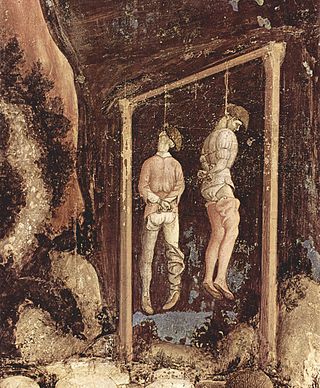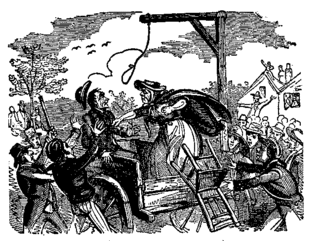Related Research Articles

Newgate Prison was a prison at the corner of Newgate Street and Old Bailey Street just inside the City of London, England, originally at the site of Newgate, a gate in the Roman London Wall. Built in the 12th century and demolished in 1904, the prison was extended and rebuilt many times, and remained in use for over 700 years, from 1188 to 1902.

Hanging is killing a person by suspending them from the neck with a noose or ligature. Hanging has been a common method of capital punishment since the Middle Ages, and is the primary execution method in numerous countries and regions. The first known account of execution by hanging is in Homer's Odyssey. Hanging is also a method of suicide.

Penal transportation was the relocation of convicted criminals, or other persons regarded as undesirable, to a distant place, often a colony, for a specified term; later, specifically established penal colonies became their destination. While the prisoners may have been released once the sentences were served, they generally did not have the resources to return home.

Louis Jeremiah Abershawe, better known as Jerry Abershawe, or Abershaw, was a notorious English highwayman who terrorised travellers, mostly along the road between Kingston upon Thames and London, in the late eighteenth century.

Gibbeting is the use of a gallows-type structure from which the dead or dying bodies of criminals were hanged on public display to deter other existing or potential criminals. Occasionally, the gibbet was also used as a method of public execution, with the criminal being left to die of exposure, thirst and/or starvation. The practice of placing a criminal on display within a gibbet is also called "hanging in chains".

John "Jack" Sheppard, or "Honest Jack", was a notorious English thief and prison escapee of early 18th-century London.

Jonathan Wild, also spelled Wilde, was a London underworld figure notable for operating on both sides of the law, posing as a public-spirited vigilante entitled the "Thief-Taker General". He simultaneously ran a significant criminal empire, and used his crimefighting role to remove rivals and launder the proceeds of his own crimes.
Margaret Dawson, also known as Margaret Henderson, was a convict sentenced to transportation. She travelled on the Lady Penrhyn as a member of the First Fleet to establish a British colony in Australia. She had a long-term relationship with the surgeon, William Balmain, whose descendants still live in Australia.

Isaac "Ikey" Solomon was a British criminal who acted as a receiver of stolen property. His well-publicised crimes, escape from arrest, recapture and trial led to his transportation to the Australian penal colony of Van Diemen's Land.

Michael Corinthos is a fictional character on General Hospital, an American soap opera on the ABC network. Introduced in 1997, the role was portrayed by several child actors—most notably Dylan Cash when the character was rapidly aged in 2002. In 2009, the character was aged again when Drew Garrett stepped into the role. Garrett was replaced by Chad Duell after one year with the series.

Joseph "Blueskin" Blake was an 18th-century English highwayman and prison escapee.

Arthur William Hodge was a Tortolan-born planter, serial killer and politician who was executed by hanging in 1811 for the crime of murdering one of his slaves. Born on the British Virgin Islands, Hodge studied at Oriel College, Oxford, matriculating in 1781 before briefly serving as an officer in the 23rd Regiment of Foot. Returning to Tortola in 1803, he settled down to a life as a plantation owner while also pursuing a political career, serving in both the Executive Council and Legislative Assembly of the British Virgin Islands. In 1811, Hodge was hanged after being found guilty of murdering a slave he owned, the first British subject to be executed for such a crime.

William Calcraft was a 19th-century English hangman, one of the most prolific of British executioners. It is estimated in his 45-year career he carried out 450 executions. A cobbler by trade, Calcraft was initially recruited to flog juvenile offenders held in Newgate Prison. While selling meat pies on streets around the prison, Calcraft met the City of London's hangman, John Foxton.
William Bryant was a Cornish fisherman and convict who was transported to Australia on the First Fleet. He is remembered for his daring escape from the penal colony with his wife, two small children and seven convicts in the governor's cutter, sailing to Timor in a voyage that would come to rank alongside that of fellow Cornishman William Bligh as one of the most incredible ever made in an open boat.

John Smith (c. 1661 – after 1727), also known by the alias John Wilson, was a London housebreaker, most notable for his three evasions of execution. His first evasion earned him the nickname of Half-hanged Smith.
Isaac Darkin, who also used the alias Dumas, was a notorious highwayman in the eighteenth century.
James Pratt (1805–1835), also known as John Pratt, and John Smith (1795–1835) were two London men who, in November 1835, became the last two to be executed for sodomy in England. Pratt and Smith were arrested in August of that year after being spied on through a keyhole allegedly having carnal knowledge of each other in a room rented by William Bonill a friend or acquaintance of one of the men, or possibly both. Bonill, although not present when the men were spied on, was nevertheless transported to Australia as an accessory to Pratt and Smith's alleged crime, where he died.
William Spiggot was a highwayman who was captured by Jonathan Wild's men in 1721. During his trial at the Old Bailey, he at first refused to plead and was therefore sentenced to be pressed until he pleaded. This was called Peine forte et dure. He was later executed, after a second trial when he pleaded not guilty, on 11 February 1721 at Tyburn, London.

Hannah Dagoe was an Irish basket-woman, sentenced to death for burglary. On the day of her execution, 4 May 1763, in what The Newgate Calendar described as an "extraordinary and unprecedented scene" she struggled violently with the executioner, and with the noose about her neck, flung herself from the cart before the signal was given, dying instantly.
Newman Knowlys was an English barrister and judge and the Common Serjeant of London and Recorder of London.
References
- ↑ Old Bailey Proceedings Online. Ordinary of Newgate's Account November 1740 , pg. 3.
- 1 2 3 Brayley, Edward Wedlake. Londiniana: or, Reminiscences of the British Metropolis: Including Characteristic Sketches, Antiquarian, Topographical, Descriptive, and Literary", Volume 2 (Hurst, Chance, and co., 1829), pp. 33–36.
- 1 2 "The Newgate Calendar: William Duell". pascalbonenfant.com. Retrieved 12 November 2010.
- 1 2 3 Chambers, William and Chambers, Robert. Chamber's Journal of Popular Literature, Science and Arts (W & R Chambers, 1866), p. 188.
- 1 2 The Gentleman's Magazine , Volume 262 (F. Jefferies, 1887), pg. 56.
- ↑ "Buried Alive". Snopes. Retrieved 12 November 2010.